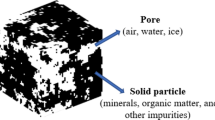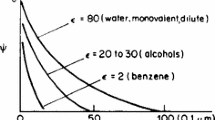Abstract
An accurate determination of the hydrological characteristics of porous media, such as the values of the porosity and effective porosity, are essential. This is important to understand the transport processes of infiltration and the movement of water and contaminants in the porous media. In this study, a laboratory soil column experiment to estimate the porosity and effective porosity of Toyoura standard sand samples, using a dielectric method termed the frequency domain reflectometry with vector network analyzer (FDR-V), was performed. The FDR-V device uses high-frequency microwaves, ranging from 0.1 to 3 GHz, to measure the complex dielectric constants of the sample. From the measured complex dielectric constant, the two parameters of the soil samples then were derived, using a proposed dielectric mixture model and tracer concentration model. The effective porosity of the soil sample is measured at 0.311 with the FDR-V dielectric method and 0.345 by the soil tracer column test. Comparing this with the calculated porosities of the soil sample, the ratio of effective porosity is approximately 78% for the dielectric method, and approximately 86% for the tracer concentration method. These different values can be explained to be within the measurement range with regard to the measurement volume for the soil column. These results indicate that measurement by the dielectric method using an FDR-V device is an efficient and useful tool for estimating the hydrological parameters of porous media because of the dielectric response of earth materials.










Similar content being viewed by others
References
Alimi-Ichola I, Gaidi L (2006) Influence of the unsaturated zone of soil layer on the solute migration. Eng Geol 85:2–8
Basile A, Mele G, Terribile F (2003) Soil hydraulic behavior of a selected benchmark soil involved in the landslide of Sarno 1998. Geoderma 117:331–346
Campbell CG, Ghodrati M, Garrido F (2002) Using time-domain reflectometry to characterize shallow solute transport in an oak woodland hillslope in northern California, USA. Hydrol Process 16:2921–2940
Chappell NA, Sherlock MD (2005) Contrasting flow pathways within tropical forest slopes of Ultisol soils. Earth Surf Process Landf 30:735–753
Field MS (2003) A review of some tracer-test design equations for tracer-mass estimation and sample-collection frequency. Environ Geol 43:867–881
Fredlund DG, Rahardjo H (1993) Soil mechanics for unsaturated soils (A Wiley-Interscience publication). Wiley, London, p 517
Friedman SP (1998) A saturation degree-dependent composite spheres model for describing the effective dielectric constant of unsaturated porous media. Water Resour Res 34:2949–2961
Hasted JB (1973) Aqueous dielectrics. Chapman & Hall, London, p 302
Huisman JA, Sperl C, Bouten W, Verstraten JM (2001) Soil water content measurements at different scales: accuracy of time domain reflectometry and ground-penetrating radar. J Hydrol 245:48–58
Ii H (1995) Effective porosity and longitudinal dispersivity of sedimentary rocks determined by laboratory and field tracer tests. Environ Geol 25:71–85
Ii H, Ohtsuka Y, Mori N, Inagaki T, Misawa S (1996) Effective porosity and specific yield of a sedimentary rock determined by a field tracing test using tritium as a tracer. Environ Geol 27:170–177
Jones SB, Wraith JM, Or D (2002) Time domain reflectometry measurement principles and applications. Hydrolog Process 16:141–153
Kamon M, Endo K, Kawabata J, Inui T, Katsumi T (2004) Two-dimensional DNAPL migration affected by groundwater flow in unconfined aquifer. J Hazard Mater 110:1–12
Kim DJ, Kim JS, Yun ST, Lee SH (2002) Determination of longitudinal dispersivity in an unconfined sandy aquifer. Hydrolog Process 16:1955–1964
Kim JH, Jeong SS, Park SW, Sharma J (2004) Influence of rainfall-induced wetting on the stability of slopes in weathered soils. Eng Geol 75:251–262
Kim JW, Choi HC, Lee JY (2005) Characterization of hydrogeologic properties for a multi-layered alluvial aquifer using hydraulic and tracer tests and electrical resistivity survey. Environ Geol 48:991–1001
Mallants D, Vanclooster M, Meddahi M, Feyen J (1994) Estimating solute transport in undisturbed soil columns using time-domain reflectometry. J Contam Hydrol 17:91–109
Marshall TJ, Holmes JW, Rose CW (1996) Soil Physics, 3rd edn. Cambridge University Press, London, pp 172–198
O’Connor KM, Dowding CH (1999) Geomeasurements by pulsing TDR cables and probes. CRC Press, West Palm Beach, p 402
Oh M, Kim Y, Park J (2007) Factors affecting the complex permittivity spectrum of soil at a low frequency range of 1 kHz–10 MHz. Environ Geol 54:821–833
Rahardjo H, Lee TT, Leong EC, Rezaur RB (2005) Response of a residual soil slope to rainfall. Can Geotech J 42(2):340–351
Reddi LN (2003) Seepage in soils: principles and applications. Wiley, London, p 402
Roth K, Schulin R, Fluhler H, Attinger W (1990) Calibration of time domain reflectometry for water content measurement using a composite dielectric approach. Water Resour Res 26:2267–2273
Santamarina JC, Klein KA, Fam MA (2001) Soils and waves. Wiley, London, p 488
Seaman JC, Bertsch PM, Miller WP (1995) Ionic tracer movement through highly weathered sediments. J Contam Hydrol 20:127–143
Topp GC, Davis JL, Annan AP (1980) Electromagnetic determination of soil water content: measurements in coaxial transmission lines. Water Resour Res 16:574–582
Turesson A (2006) Water content and porosity estimated from ground-penetrating radar and resistivity. J Appl Geophys 58:99–111
Ulaby FT, Moore RK, Fung AK (1986) Microwave remote sensing: active and passive, vol III: From theory to applications. Artech House Publishers, p 2162
Yeh YJ, Lee CH, Chen ST (2000) A tracer method to determine hydraulic conductivity and effective porosity of saturated clays under low gradients. Ground Water 38(4):522–529
Acknowledgments
This research was supported by grant (2-2-3) from the Sustainable Water Resources Research Center of the 21st Century Frontier Research Program.
Author information
Authors and Affiliations
Corresponding author
Rights and permissions
About this article
Cite this article
Kim, MI., Jeong, GC., Chung, IM. et al. Experimental assessment of the infiltration properties of a coarse soil medium in a dielectric infiltration test. Environ Geol 57, 591–600 (2009). https://doi.org/10.1007/s00254-008-1328-7
Received:
Accepted:
Published:
Issue Date:
DOI: https://doi.org/10.1007/s00254-008-1328-7




